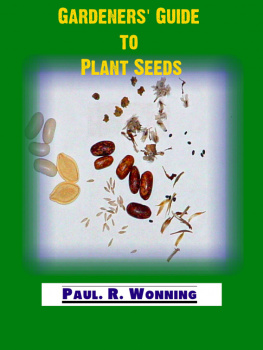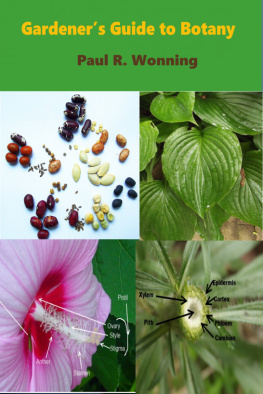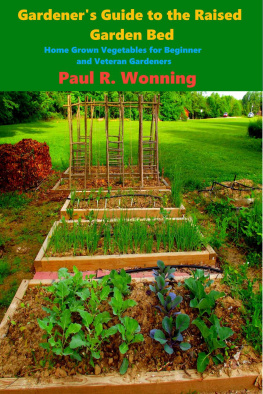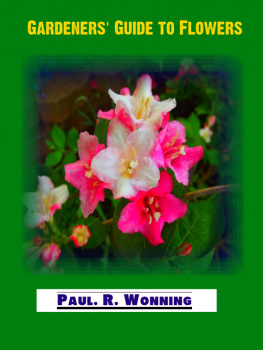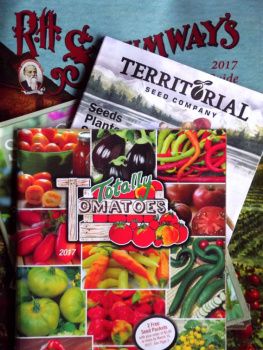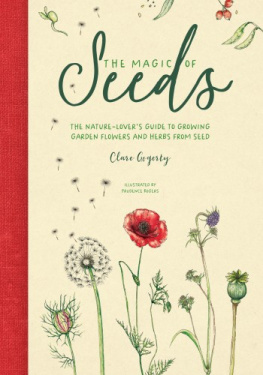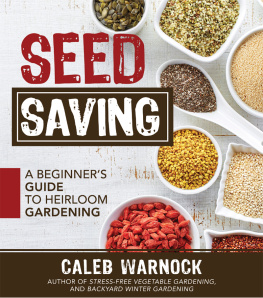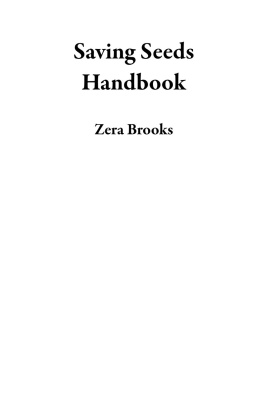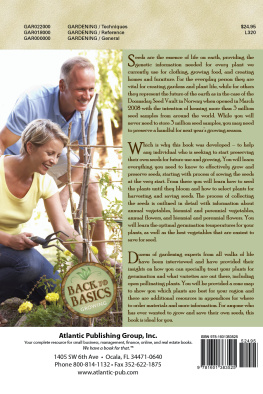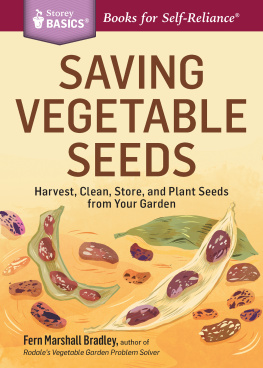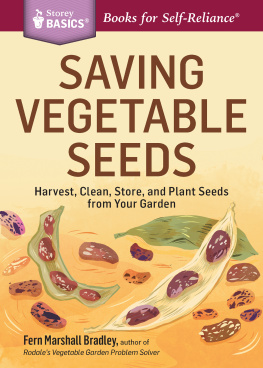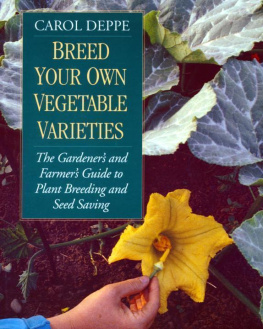Gardeners Guide to PlantSeeds
Propagation, Collection, Storage andGermination of Seeds
Gardeners Guide to Botany Series -Book 1
Paul R. Wonning
Description
Gardeners Guide toPlant Seeds is a comprehensive guide on thepropagation, storage, collection and germination of flower andvegetable seeds.
This plant seed guide also containsa comprehensive list of seed catalogs. These catalogs listthousands of varieties of flower and vegetable seeds.
Gardeners Guide toPlant Seeds covers the structure andgermination of seeds. Sections also cover saving, harvesting andseed storage. It is a comprehensive encyclopedia of knowledge aboutthe flower and vegetable seeds grown in the homegarden.
Sections of thisguide also cover seed structure, formation and dispersal seeds.Though not a specific guide to individual plants, The Gardeners Guide to Plant Seeds contains a host of information about the seedsthey need. This is basic information the gardener needs for seeds.It is a great aid to the task of germination and starting theseedlings on to their task of producing vegetables and flowers forour use.
Gardeners Guide toPlant Seeds is the first volume inthe Gardeners Guide to Botany series. The other books in the series cover allfacets of the plants we use in our gardens. They include the roots,stems, leaves and flowers of the plants we grow for flowers andvegetables in the garden. They contain information on thepropagation, harvesting and storage of the plants we need to enjoyor consume.
At the end of this book, gardenerswill find the seed catalogue listings of immense value. Use them tosearch for just the right plants to grow in your garden.
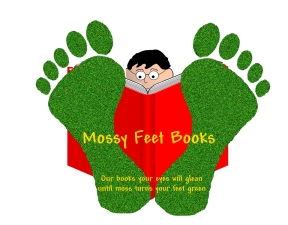
Gardeners Guide to PlantSeeds
Published Paul R.Wonning
Copyright 2016 by Paul R.Wonning
Smashwords Edition
This ebook is licensed foryour personal enjoyment only. This ebook may not be re-sold orgiven way to other people. If you would like to share this bookwith another person, please purchase an additional copy for eachrecipient. If you're reading this book and did not purchase it, orit was not purchased for your use only, then please return toSmashwords.com and purchase your own copy. Thank you for respectingthe hard work of this author.
Title
All rightsreserved.
All characters in this bookare fictional and any resemblance to actual persons, living ordead, is entirely coincidental.
If you would like emailnotification of when new installments of
this series are available,email the author for inclusion in the subscription list.
Paul R. Wonning
Mossyfeetbooks@gmail.com
Facebook Mossy Feet Books
Mossy FeetBooks
IndianaPlaces

Table of Contents
Botanicalterms
Formation and Structure of theSeed in Angiosperms
Methods of SeedDispersal
Gathering and HarvestingSeed
Seed Storage
SeedDormancy
SeedGermination
Germination MadeSimple
Planting Flower and VegetableSeed Indoors
Seed Planters For TheGarden
Seed Planting Guide - AnnualFlowers
Seed Planting Guide -Vegetables
Seed Starting Mediums andSoil
Germination of Seeds With a HeatMat
Seed Starting Trays APrimer
Seed Catalogs
Acknowledgements
About theAuthor
Sample Chapter
Chapter 1 The Plant Root -Introduction
Also In thisSeries
Gardeners' Guide to PlantSeeds
Gardeners' Guide to thePlant Root
Gardeners' Guide toFlowers
Gardeners' Guide ToLeaves
Gardeners' Guide To PlantStems
Gardeners' Guide ToBotany
Gardeners Guide to PlantSeeds
Paul R. Wonning
Introduction
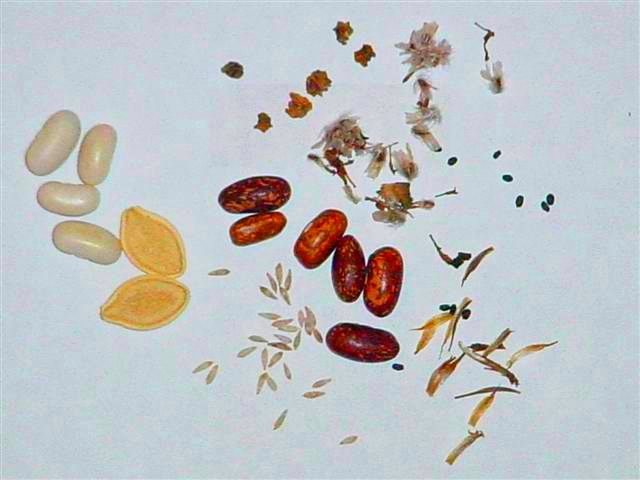
A seed is kind of anamazing thing. A seed packs everything it needs to grow a plant.The type of plant, how big it will grow, what kind of leaves itwill have, and its flower color. Literally the entire blueprint ofthe plant is contained within that tiny package we call aseed.
All flowering plants growfrom seeds, and that includes just about everything found in theflower and vegetable garden, excluding ferns, fungi, and mosses.The tiny seed produces everything from the diminutive moss roses tothe huge oak tree.
Seed size has virtually noimpact upon the size of plant that grows from it. Some of thelargest plants may grow from seed the size of dust, and very largeseeds sometimes produce diminutive plants.
Seeds in the wild dependupon a number of different mechanisms to allow them to reach theproper locations and conditions for them to germinate. Some havefluffy wings to allow the wind to disperse them over a widearea.
Others have Velcro-likespurs to stick to animals fur. Others clothe themselves in fleshyfruit, which in turn is eaten by birds and animals and thusdispersed. Many of these need the harsh enzymes produced by thedigestive systems of these animals to dissolve the seed coatsufficiently to allow germination.
Seeds are of immensecommercial value to us. Corn supplies both human food and feed forthe livestock we depend upon for meat and protein. Corn alsoprovides ethanol for fuel for our vehicles. Soybeans supplyplastics, cooking oils and other important products. Other graincrops find use as bread, beer, and other items we use in oureveryday life.
The amazing seed packseverything needed to grow a plant into a compact package. Allflowering plants produce seed that not only serves as a method ofreproduction for the plant but also a major food source for humans,animals and insects. Seeds are an indispensable part of ourworld.
Botanical terms used in thisarticle:
Angiosperms
Angiosperms are the groupof plants we know of flowering plants, as opposed to thegymnosperms, or "naked seed" plants and spore producing plants likeferns and fungi. The word "angiosperm" comes from the Greek words"angeion", which means "vessel", and "sperma," which means "seed."The term refers to the vessel (fruit) contained seeds of this vast,diverse groups of plants. The angiosperms are the most numerous ofall plant types and occupy virtually every climate zone in theworld. There are about 250,000 species of angiosperms on earth.Angiosperms appeared on Earth approximately 150 million yearsago.
Anther
The anther is the pollenbearing part of the stamen of a flower. The anther is located atthe apex of the stamen. The anther is the male reproductive part ofthe flower and produces the pollen.
Cell
The cell is the basicbuilding block of a living organism, plant or animal. The term"cell" originated from the first man, Robert Hooke, to look at oneusing a microscope of his own construction in 1665. The wordoriginates from the Latin word "cella," which means "small room." Aplant cell is a complex unit that contains the necessary componentsfor a plant to convert sunlight into energy, allowing the plant togrow and reproduce.
Dicots
The dicots are one of thetwo major divisions of the angiosperms, the other being monocots.The term is derived from two words, "di," which means two, and"cots" which is an abbreviation of the word cotyledons. Thecotyledon is the first portion of the plant to emerge when the seedgerminates. The cotyledon's purpose is to supply food to thedeveloping plant until the true leaves form and can manufacturefood. Dicots have two of these seed leaves and monocots likegrasses have only one.
Next page
